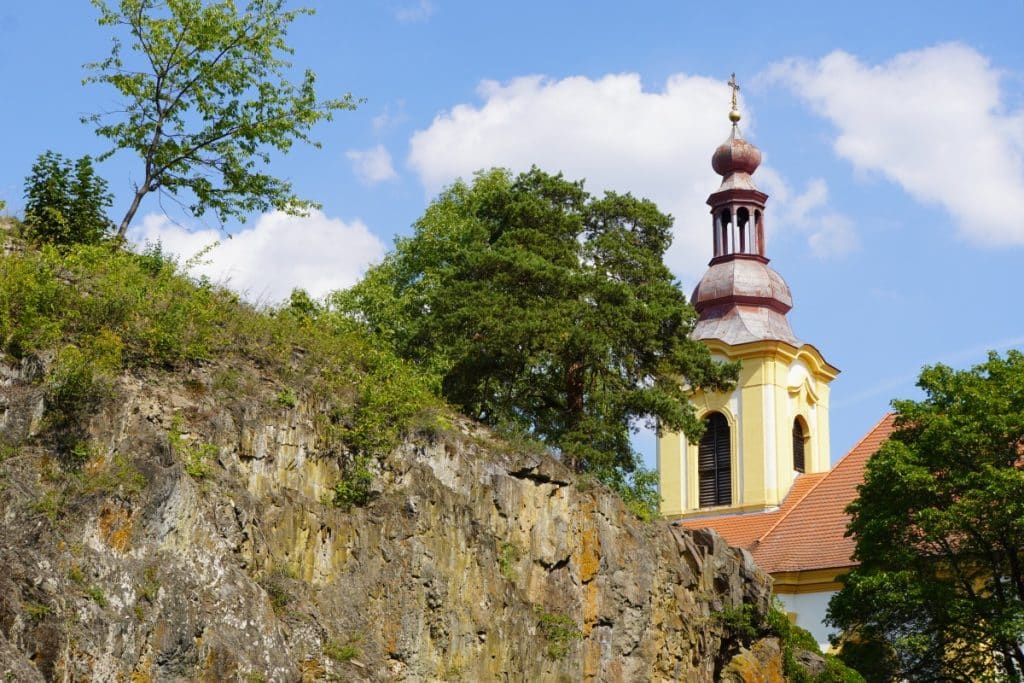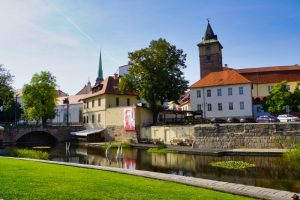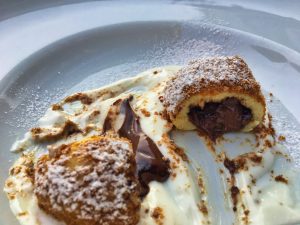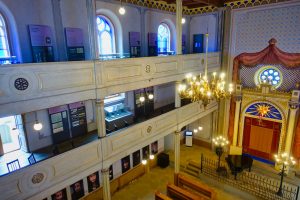We arrive by car in Rabštejn nad Střelou and have already driven past again. The small town claims to be the smallest town in Central Europe… it almost seems like it’s true.
Rabštejn nad Střelou, also known as Rabenstein an der Schnella, is located around 30 kilometres north of Pilsen directly on the small river Střela. The few houses are almost all located on the right bank on a rocky outcrop.
Once upon a time…
Rabštejn nad Střelou, first mentioned in written records in the 13th century, has deep medieval roots. The town is strategically located on important trade routes that led through western Bohemia.
Around 1296, the castle passed to Ulrich Pflugk. The Pflug family of Rab(en)stein (Pluhové z Rabštejna) remained resident at Rabenstein Castle until the 16th century.

Rabštejn Castle, which towers over the town, served not only as a residence but also as a defensive fortress to ward off possible attacks and invasions. The town was granted city rights in 1337. Its favourable location on the Střela River made Rabštejn an important crossroads for merchants transporting goods from all over Europe.
Nevertheless, it was also a turbulent time. Christoph Pflug was summoned to court in 1509 for various disputes with the Schlik family, but failed to appear. As a result, he was sentenced to forfeit his property, including Rabenstein Castle. Pleading for clemency, he managed to ensure that he “only” lost his property.
In 1549, the castle and the entire town burned down and all documents were lost. In the following years, the owners changed constantly and there was never any real peace. Around 1705, the then owner had the Renaissance castle baroqueised and sold it on just a few years later.
After the Servite monastery was dissolved in 1787, the monastery church found a new purpose as a parish church. The previously used church of St Matthew, which was in a dilapidated state, was demolished. The site of the former monastery also found a new use: it was used as both a rectory and a parish school.

In 1819, the defence tower of Rabenstein Castle collapsed into the courtyard of the former monastery. This accident caused considerable damage and destroyed the stable and granary of the parish.
In 1837, the total area of the Rabenstein estate was around 3700 hectares. The town itself consisted of 83 buildings in which 513 people lived, including two Jewish families. The parish church and the parish school were under the patronage of the manor. Rabenstein also had a manorial castle with a brewery and a distillery as well as three inns.

The main source of income for the inhabitants was trade and commerce. Tolls were also charged for crossing a stone bridge over the River Střela.
Rabštein has been used as a Czech place name since the end of the 19th century. The last owner of the estate until 1945 was Theresia Countess von Seilern-Aspang, née Countess Lažanská.
As part of the Munich Agreement of 1938, Rabštejn nad Střelou was incorporated into the German Reich and was part of the Luditz district until 1945. In 1939, the municipality had 312 inhabitants. After the end of the Second World War, Rabštejn nad Střelou became part of Czechoslovakia again and the German-speaking population had to leave the area.

What to see in Rabštejn nad Střelou?
Even small towns have their hidden sights, and in Rabštejn nad Střelou you can discover them all on a short tour. To get to know the town better, you can follow the Rabštejn nature trail, which starts at the upper edge of the town and presents the most interesting places in Rabštejn and the surrounding area at fourteen stations. The trail stretches for around seven kilometres.
Jewish cemetery
The Jewish cemetery in Rabštejn nad Střelou was probably founded in 1654. It is located on a slope along the road leading from the post office to the River Střela.
The gravel path leads quite steeply downhill, and behind a wall you will eventually discover the first gravestones of the rather small cemetery.

The first Jewish families (sources report 3 families) arrived in the village around 1654. In the 19th century, there were still 2 families, and it is said that there were never more than 15 people. The last family left the community before the Nazis in 1938.
A gate leads to the cemetery, which is divided into two sections. The lower section is newer, the older section is raised and accessible via a few steps. There are not many gravestones to be seen. As is customary in Jewish cemeteries, the stones remain as they are. If a stone tips over, it just tips over, if it sinks into the ground, that’s that, and if the stone disappears, it’s gone. No expensive and time-consuming grave maintenance is carried out here. Anyone who visits a grave places a small stone there as a memorial. I like that.

River crossing and fun in the water
A stone bridge crosses the River Střela at the edge of the town. Kamenný most v Rabštejně nad Střelou was probably built in the years 1335-1340. At this time, the original castle was rebuilt and the town was founded in the outer bailey. If this date is correct, the bridge would be older than the Charles Bridge in Prague and the second oldest preserved stone bridge in the Czech Republic.

The bridge is made of coarse-grained sandstone and rough quarry stone. It is 55 metres long and 4.3 metres wide. The arches are around six metres high. The bridge can only be driven on in one lane. When I was travelling there, the bathing area for the local children was under the bridge. There was a cheerful squeaking and the splashing of water. I watched the colourful hustle and bustle a little enviously, as it was quite warm and it would have been nice to cool off a little.

I have since read that the bridge is also often used as a film location. Film scenes from The Lucky Loser and St. John’s Wreath were shot here and the remix of Depeche Mode’s Personal Jesus video was filmed here in 2011.
Former Servite monastery and baroque Church of the Seven Sorrows of Mary
The Servites are a Catholic monastic order officially known as the “Order of the Servites” or “Ordo Servorum Mariae”, which means “Order of the Servants of Mary”. They were founded in Florence in the 13th century and were particularly dedicated to the worship of Mary, the mother of Jesus.

Rabštejn nad Střelou is home to a Baroque Servite monastery with a church on the castle grounds. Construction work on the monastery began in 1672, while the Church of Our Lady of Seven Sorrows was built much later. It is probably the work of the architect Anselm Lurag, but there are no precise records of this.
After the order was dissolved, the building was used as a rectory and school. Later, it also housed a hotel. Today, the building looks quite dilapidated and unused from the outside. However, there are curtains on the windows, so perhaps the rooms are being used after all.
Castle Rabštejn nad Střelou
The castle was built on the site of a former 14th century castle and was initially the seat of the Černín family, later the Kolovrat family and finally the Lažanský family, who owned the castle until 1945. The building was then used by the army as a children’s recreation home and educational centre. After “standing around” unused for 10 years, the site is now being used again.

The chateau consists of several buildings, including a main residential building, farm buildings and other outbuildings. Rabštejn nad Střelou Chateau is a single-storey Baroque-style building with a half-floor attic. The façade is rather plain and decorated with folded cornices and free-standing pilasters. It can be visited by tourists and offers insights into the history of the region. It is also used as a venue for cultural events and celebrations.
I was able to take part in a guided tour of the castle. It began in the former stables, which are now used as an event room. From there, we went straight into the castle.

First we visited a room where we could see a small exhibition of traditional costumes from the region. Some of them were really beautiful and hand-embroidered.


The wide, grand-looking staircase in the entrance area then led us to the first floor. However, before we could visit the rooms, our shoes had to be fitted with fabric covers. This way, we protected the parquet flooring and glided more or less elegantly through the property. The rooms we were allowed to visit are used for events such as weddings. It is even possible for the wedding couple to spend the night in the castle. I would have imagined a more sumptuous room, but after a long celebration, the wedding couple certainly won’t mind.

The path then led us to a large viewing platform that ended directly at the castle walls. From here, we had a view over the seemingly endless surrounding forests. If you leaned out a little, you could see the stone bridge, and to the other side I could see even more of the castle grounds and the former monastery church.

An external staircase took us to the foot of the castle walls. There we were shown a cannonball in the wall and then led back to the exit.
Tip: The castle and grounds are only open during the guided tour. Just wait at the gate – it will be unlocked!

Is the visit worthwhile?
I think those who only want to visit the castle will perhaps expect a little more. Perhaps because the tour was in Czech, I simply didn’t have the right information. So it was a visit to the interior with a bit of a view.
However, if you want to explore the area, you should take good shoes with you and explore the signposted hiking trail. The nature is beautiful, especially along the river where you can experience pure relaxation.
The visit took place as part of a press trip.


























Leave a Reply